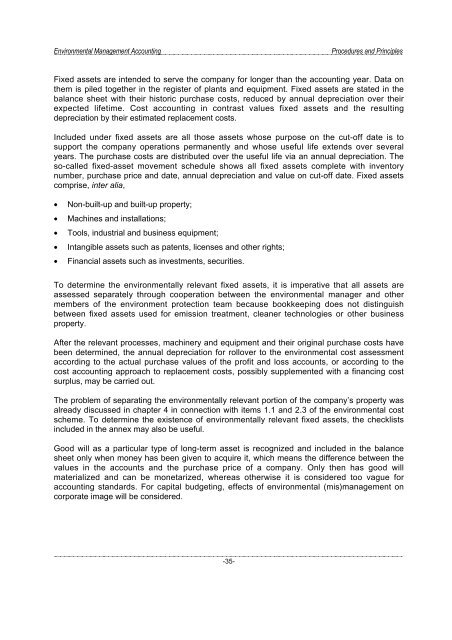Environmental Management Accounting Procedures and Principles
Environmental Management Accounting Procedures and Principles
Environmental Management Accounting Procedures and Principles
Create successful ePaper yourself
Turn your PDF publications into a flip-book with our unique Google optimized e-Paper software.
<strong>Environmental</strong> <strong>Management</strong> <strong>Accounting</strong><br />
<strong>Procedures</strong> <strong>and</strong> <strong>Principles</strong><br />
Fixed assets are intended to serve the company for longer than the accounting year. Data on<br />
them is piled together in the register of plants <strong>and</strong> equipment. Fixed assets are stated in the<br />
balance sheet with their historic purchase costs, reduced by annual depreciation over their<br />
expected lifetime. Cost accounting in contrast values fixed assets <strong>and</strong> the resulting<br />
depreciation by their estimated replacement costs.<br />
Included under fixed assets are all those assets whose purpose on the cut-off date is to<br />
support the company operations permanently <strong>and</strong> whose useful life extends over several<br />
years. The purchase costs are distributed over the useful life via an annual depreciation. The<br />
so-called fixed-asset movement schedule shows all fixed assets complete with inventory<br />
number, purchase price <strong>and</strong> date, annual depreciation <strong>and</strong> value on cut-off date. Fixed assets<br />
comprise, inter alia,<br />
• Non-built-up <strong>and</strong> built-up property;<br />
• Machines <strong>and</strong> installations;<br />
• Tools, industrial <strong>and</strong> business equipment;<br />
• Intangible assets such as patents, licenses <strong>and</strong> other rights;<br />
• Financial assets such as investments, securities.<br />
To determine the environmentally relevant fixed assets, it is imperative that all assets are<br />
assessed separately through cooperation between the environmental manager <strong>and</strong> other<br />
members of the environment protection team because bookkeeping does not distinguish<br />
between fixed assets used for emission treatment, cleaner technologies or other business<br />
property.<br />
After the relevant processes, machinery <strong>and</strong> equipment <strong>and</strong> their original purchase costs have<br />
been determined, the annual depreciation for rollover to the environmental cost assessment<br />
according to the actual purchase values of the profit <strong>and</strong> loss accounts, or according to the<br />
cost accounting approach to replacement costs, possibly supplemented with a financing cost<br />
surplus, may be carried out.<br />
The problem of separating the environmentally relevant portion of the company’s property was<br />
already discussed in chapter 4 in connection with items 1.1 <strong>and</strong> 2.3 of the environmental cost<br />
scheme. To determine the existence of environmentally relevant fixed assets, the checklists<br />
included in the annex may also be useful.<br />
Good will as a particular type of long-term asset is recognized <strong>and</strong> included in the balance<br />
sheet only when money has been given to acquire it, which means the difference between the<br />
values in the accounts <strong>and</strong> the purchase price of a company. Only then has good will<br />
materialized <strong>and</strong> can be monetarized, whereas otherwise it is considered too vague for<br />
accounting st<strong>and</strong>ards. For capital budgeting, effects of environmental (mis)management on<br />
corporate image will be considered.<br />
-35-




